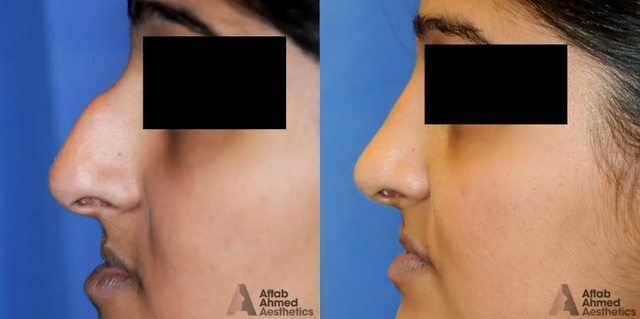How Long Does a Nose Job Take? Full Rhinoplasty Timeline
31st October 2025 |
By Shan Harland
Answering the question: How long does a nose job take?
A typical nose job, also known as rhinoplasty, takes between 1.5 to 3 hours. The duration of your rhinoplasty procedure depends on the complexity of the changes, whether you're having open rhinoplasty, closed rhinoplasty, or a revision rhinoplasty. Some simpler surgeries take around 90 minutes, while more involved procedures may take longer due to adjustments to the nasal bones, cartilage, and overall nasal function.

Quick Rhinoplasty Surgery Timeline
Stage
Duration
Initial consultation
30–60 minutes
Surgery
1.5 to 3+ hours
Recovery period (return to work)
7–10 days
Swelling reduces
3–6 weeks
Final results visible
6–12 months
What Happens Before Rhinoplasty?
Initial Consultation
Before undergoing nose reshaping surgery, you'll meet your surgeon for a thorough initial consultation. This typically lasts between 30 minutes to an hour, and is essential to assess:
- Your nasal shape, skin thickness, and cartilage and bone structure.
- Whether you’re a good candidate for cosmetic surgery or have concerns like a deviated septum, breathing problems, or a blocked nose.
- Your goals, and whether they are realistic expectations.
You may also discuss different rhinoplasty procedures available, such as:
- Open rhinoplasty – involves a small incision between the nostrils.
- Closed rhinoplasty – all incisions are hidden inside the nose.
- Revision rhinoplasty – for correcting previous surgeries or complications.
How Long Does Rhinoplasty Surgery Take?
The actual rhinoplasty procedure generally takes:
- 1.5 to 2 hours for basic cosmetic changes, such as adjusting the nose tip, reducing the nostrils, or smoothing a bump.
- 2.5 to 3+ hours for more complex changes involving the nasal bones, cartilage grafting, or correcting breathing difficulties.
- Longer durations for revision rhinoplasty, as previous scar tissue and surgical changes make the process more complex.
This is typically an outpatient procedure, meaning you can return home the same day once you're safely out of anaesthesia.
What Affects How Long a Nose Job Takes?
Several factors influence how long your nose surgery will last:
- Open vs. closed rhinoplasty – open procedures may take longer due to the extra incision and visibility.
- Revision rhinoplasty – can extend the procedure time due to correction of past work.
- Complexity of reshaping – work on the nasal tip, underlying bone, or correcting a deviated septum takes more time.
- Patient anatomy – differences in skin, bone, and cartilage thickness may require more precision.
How Long Does It Take to Recover From Rhinoplasty?
Rhinoplasty recovery happens in stages. Here's what to expect:
Week 1 – Initial Healing
- Swelling and facial bruising are common.
- A nasal splint stays in place for 5–7 days.
- Most patients can return to work within 7–10 days.
- Keep your head elevated and avoid sun exposure and wearing glasses directly on the nose.
Week 2–4 – Moderate Recovery
- Most swelling subsides, but the nasal tip may still appear puffy.
- Avoid strenuous exercise and any pressure to the surgical site.
- You may notice the new shape becoming more visible.
Months 3–6 – Long-Term Healing
- Final results start to become visible.
- Some residual swelling may persist around the nose tip, especially with thicker skin.
Up to 12 Months – Full Healing
- Full rhinoplasty recovery can take up to a year.
- During this time, the bones and cartilage continue to settle.
- Be patient, the healing process is gradual, and rushing it may increase the risk of complications.
Step-by-Step: The Rhinoplasty Procedure
Here's a simple breakdown of the rhinoplasty surgery steps:
- Anaesthesia – usually general; takes 15–20 minutes to administer safely.
- Incisions – made either inside the nostrils (closed rhinoplasty) or across the columella (open rhinoplasty).
- Reshaping – the surgeon adjusts cartilage and bone to improve appearance and nasal function.
- Closing – incisions are stitched; some are dissolvable.
- Aftercare begins – you’ll receive instructions to manage the recovery process.
Why Time Shouldn’t Be Rushed in Rhinoplasty
Although you may wonder 'how long does rhinoplasty take', the focus should be on safe, precise outcomes. Rushing any stage, from the consultation to the healing process, increases the risk of infection, severe pain, or subpar results.
Trust a board certified plastic surgeon who takes the time to understand your needs, and approaches each case with care and professionalism.
Final Tips for Patients
- Prepare for at least 7–10 days off work.
- Avoid strenuous activity for the first few weeks.
- Protect your nose from injury and sun exposure during the recovery time.
- Stay in touch with your surgeon throughout the recovery period for best support.
Frequently Asked Questions about Rhinoplasty
Is rhinoplasty painful?
Discomfort is normal in the first few days, but severe pain is uncommon. Most patients describe the feeling as pressure or congestion, particularly if nasal bones were adjusted or if you had surgery to correct a deviated septum. Pain relief is usually managed with over-the-counter or prescribed medication. Keeping your head elevated and using cold compresses can also help reduce swelling and discomfort.
What’s the difference between open and closed rhinoplasty procedures?
- Open rhinoplasty involves a small incision between the nostrils, giving the surgeon direct visibility of the bone and cartilage. It’s often used for more complex reshaping or revision rhinoplasty cases.
- Closed rhinoplasty uses internal incisions only, with no external scarring. It’s typically used for more straightforward nose reshaping surgery and may slightly reduce procedure time and recovery.
Your surgeon will recommend the best option based on your nasal anatomy and goals.
How long should I avoid exercise after rhinoplasty?
You should avoid strenuous exercise and heavy lifting for at least 3–4 weeks after your nose surgery. Activities that increase blood pressure or cause facial strain can increase swelling and risk of bleeding. Light walking is usually safe after the first week, but always check with your surgeon before resuming more vigorous activities.
Can rhinoplasty fix breathing problems?
Yes, functional rhinoplasty procedures can address breathing difficulties caused by a deviated septum, collapsed nasal valves, or other structural issues. These surgeries often involve modifying the bones and cartilage inside the nose to improve nasal function while preserving or enhancing the overall appearance.
Is revision rhinoplasty more complex?
Yes, revision rhinoplasty is usually more challenging than primary procedures. It often requires correcting scar tissue, restoring structural support, or improving both function and appearance after a previous surgery. This type of surgery typically takes longer and has a more involved recovery process. It’s important to work with a board certified plastic surgeon who has experience in complex nasal surgery.
